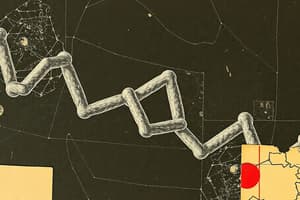Podcast
Questions and Answers
What are proteins composed of?
What are proteins composed of?
Unbranched polymers of amino acids linked by peptide bonds.
What is the relationship between amino acids in peptide formation?
What is the relationship between amino acids in peptide formation?
- Linked by peptide bonds (correct)
- Linked by hydrogen bonds
- Linked by ionic bonds
- Linked by disulfide bonds
The peptide bond has complete double-bond character.
The peptide bond has complete double-bond character.
False (B)
What charge does the amide nitrogen have in the peptide backbone?
What charge does the amide nitrogen have in the peptide backbone?
Which of the following statements about peptide classification is true?
Which of the following statements about peptide classification is true?
Peptide bond formation results in the release of ______.
Peptide bond formation results in the release of ______.
What must occur for dissociation of heteromultimer proteins?
What must occur for dissociation of heteromultimer proteins?
Oxidation of a disulfide bond produces cysteic acid.
Oxidation of a disulfide bond produces cysteic acid.
The peptide backbone consists of a repeated sequence of ______.
The peptide backbone consists of a repeated sequence of ______.
Flashcards are hidden until you start studying
Study Notes
Primary Structure of Proteins
- Proteins are unbranched polymers of amino acids (AAs) linked head to tail through covalent peptide bonds, forming an amide linkage.
- Peptide bond formation involves the release of water (H₂O) during the bond creation between the carboxyl group of one AA and the amino group of another.
- The peptide backbone consists of a repeated sequence of atoms: -N-Cα-Co.
- N: Amide nitrogen
- Cα: Alpha-carbon atom (chiral center, except for Gly)
- Co: Carbonyl carbon
- The conformation of the peptide bond is energetically favored as the carbonyl oxygen and amide hydrogen are trans to each other, minimizing steric hindrance.
- The peptide bond exhibits partial double-bond character, resulting from resonance and contributing to rigidity in the polypeptide chain.
- Peptide bonds have approximately 40% double-bond character, preventing free rotation about the Co-N bond.
Polypeptide Backbone Properties
- The peptide backbone is relatively polar, with a protonated amide nitrogen and a negatively charged carbonyl oxygen creating a permanent dipole moment.
- The backbone's chemical reactivity is limited, with proton gain or loss occurring only at extreme pH levels.
- Peptides can be categorized based on the number of amino acids they comprise, such as dipeptides, tripeptides, tetrapeptides, and oligopeptides.
Steps for Protein Sequencing
- Step 1: Separation of Polypeptide Chains
- Heteromultimer proteins are dissociated into their individual polypeptide chains through extreme pH, 8 M urea, 6 M guanidinium hydrochloride, or high salt concentrations.
- Step 2: Cleavage of Disulfide Bridges
- Disulfide S-S bridges, which can link polypeptide chains, must be cleaved to isolate individual chains.
- Performic acid oxidation converts disulfides into cysteic acids, preventing recombination due to electrostatic repulsion.
- Reducing agents like 2-mercaptoethanol or dithiothreitol (DTT) can break S-S bonds, allowing formation of thiol (-SH) groups that may recombine later.
- Alkylating agents (iodoacetate, 3-bromopropylamine) are employed after reduction to prevent new disulfide link formation.
- Step 3: N-terminal and C-terminal Residue Identification
- The N-terminal and C-terminal residues are determined to help reconstruct the complete amino acid sequence.
- Step 4: Fragmenting and Sequencing
- Polypeptide chains are cleaved into smaller fragments for analysis of amino acid composition and sequence.
- Different cleavage techniques are applied repeatedly to generate overlapping sets of fragments for accurate sequence reconstruction.
Studying That Suits You
Use AI to generate personalized quizzes and flashcards to suit your learning preferences.




